The Staff, the Snake and the Shamrock: St Patrick in Art
by Rachel Moss
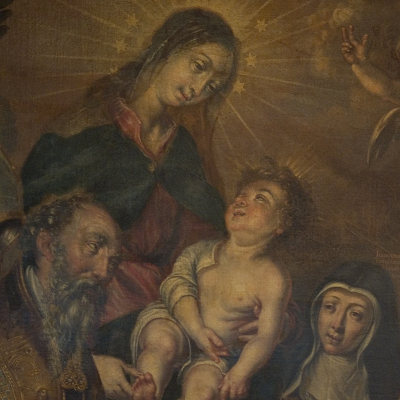

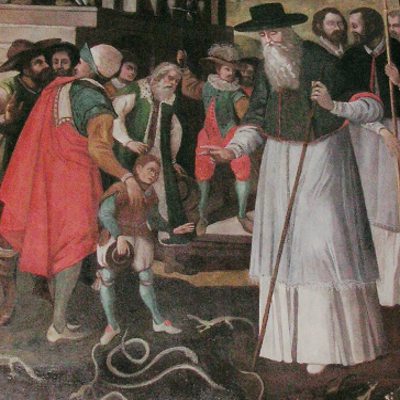
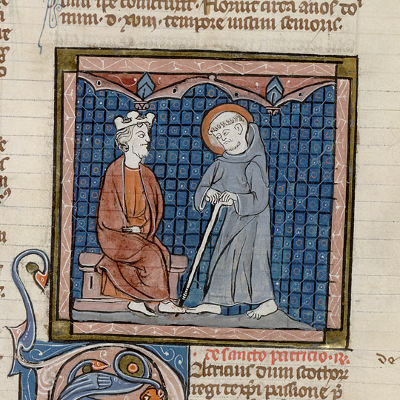
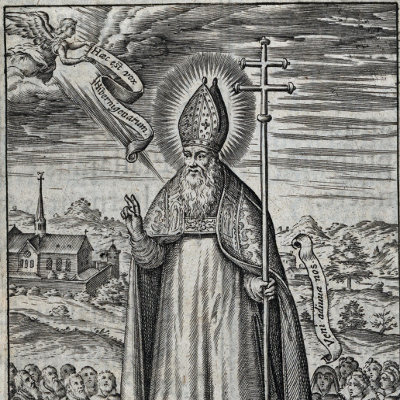
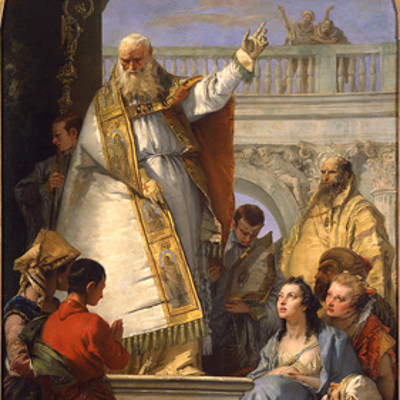
The image of a bearded man wearing a mitre and carrying a staff or crozier has become almost synonymous with the patron saint of Ireland, in particular when his vestments are green and adorned with shamrocks and a snake slithers around his feet. However, were a contemporary of Patrick to be confronted with such an image, it is certain that he would not recognize the Saint in the form with which we are familiar today. The manner in which he has come to be depicted represents the culmination of over a thousand years of art, influenced by various texts and evolving belief systems, both localized and international.1
Visual representations of saints were relatively commonplace in Europe from as early as the fifth century. Devotional images and reliquaries created a focal point for prayer, and the walls of the churches were adorned with narrative scenes that reinforced their sanctity. Miniatures depicting their miraculous activities illustrated the pages of various religious texts and helped further to establish an unambiguous visual language by which they could be recognized. In this way images of individual saints came to be clearly identified through their association with a particular object or attribute, often associated with their life and miracles, or, in the case of martyred saints, the manner in which they met their death.2
In Ireland, there is clear evidence of devotion to local saints and the active promotion of them through the writing of hagiographies and enshrinement of relics from as early as the seventh century. However, the degree to which native cults may have been expressed visually, in particular through the figurative representation of Irish saints, is unclear. Tírechán, one of Patrick’s earlier biographers, mentions ‘wooden images’, suggesting the existence of devotional statues in Ireland in the seventh century.3 Cogitosus’ Life of St Brigit similarly describes the decoration of the church at Kildare with painted linen hangings.4 Unfortunately neither writer expands on the subject matter of these now lost early Irish art forms; but Giraldus Kambrensis’ reference to the manner in which St Kevin was traditionally depicted in Ireland, holding a blackbird in his hand, would seem to confirm that figurative representations of native saints certainly did exist before the late twelfth century.5
The largest surviving corpus of figurative imagery from the pre-Norman period, the sculpted high crosses, probably does include representations of Irish saints, but securely identifying them is problematic to say the least. Arthur Kingsley Porter suggested that some of the more enigmatic figures represented on the Cross of the Scriptures at Clonmacnoise might be interpreted as the figure of Patrick.6 More convincingly, Peter Harbison has argued that two seated figures carved on the ninth-/tenth-century cross of Sts Patrick and Columba at Kells represent the saints to whom the cross is dedicated.7 However, in both examples the figures identified as St Patrick have no clear attributes other than that they are dressed as ecclesiastics, so, short of other evidence, it is impossible to identify them with absolute certainty.
It is with images such as these that the difficulty in clearly identifying early images of St Patrick begins to emerge. In common with medieval depictions of European saints one might expect Patrick to be portayed with a particular attribute or emblem, something that would distinguish him for the viewer. One of the most significant objects associated with Patrick was the Bachall Ísu or ‘Staff of Jesus’ – a staff which had, according to tradition, been given to the Saint directly by Christ.8 The staff was for a long time the badge of office of the Abbots of Armagh, with the addition from c.937 of the Book of Armagh and from the mid-eleventh century the ‘Bell of the Testament’, a bell attributed to Patrick. One might expect early images of the Saint to include these attributes, and in particular the Bachall Ísu, which from the 1180s until its destruction in 1538 was kept at Christchurch Cathedral Dublin as one of its most prized relics. One of the great promoters of the Anglo-Norman cult of Patrick, John de Courcy, minted coins with the Saint’s name, together with a representation of a cross staff – so this might reasonably be interpreted as one of the most recognizable symbols of the Saint from the twelfth century.9
 |
| Fig. 1 |
The earliest definite Irish depiction of St Patrick is found on the so-called Fiacail Phádraig, the reliquary shrine of the Saint’s tooth from Connacht, now in the collection of the National Museum of Ireland [fig 1].10 The twelfth-century shrine was renovated by Thomas de Bermigham, Lord of Athenry in the 1370s and the front decorated with a Crucifixion and, originally, the figures of nine named saints. St Patrick, located directly beneath the Crucifixion, is flanked by St Benen [Benignus] and St Brigit (now missing) on the left side, and St Columcille and St Brendan on the right. Patrick is represented as an ecclesiastic wearing a low mitre, holding a cross staff, and clean shaven. Here we might suggest that Patrick is holding the Bachall Ísu, except that the depiction is almost identical to another saint?s on the shrine, also holding a cross staff, whose name has now become too worn to be legible.
 |
| Fig. 2 |
Another labelled image is found over the north doorway (c.1460) of the cathedral at Clonmacnoise, Co. Offaly [fig 2]. Here three figures, St Dominic, St Patrick and St Francis have been inserted under the hood mould of the portal on which their names are inscribed. The varying sizes and manner in which the three figures are carved suggest that they may originally have been made for a different location, although stylistically they fit in with the date of the doorway. The figures of Sts Francis and Dominic are immediately recognizable, but the figure of St Patrick is depicted as an ecclesiastic with a low mitre, apparelled amice and maniple over his left arm. He is clean shaven, and holds a crozier, not a cross staff.11
 |
| Fig. 3 |
This depiction can also be compared with the named figure of the Saint on the thirteenth-century great seal of Glastonbury Abbey. Here he is accompanied by Sts Dunstan and Benen [Benignus]. St Dunstan carries a cross staff, but the two Irish saints carry croziers [fig 3].12
 |
| Fig. 4 |
On the sixteenth-century McCragh tomb at Lismore Cathedral, Patrick is depicted on the end of the tomb, together with St Catherine of Alexandria and St Carthage, and here the Saint, again depicted as a clean-shaven ecclesiastic, carries a triple-armed cross staff distinguishing him from St Carthage who carries a crozier [fig 4].
These four examples demonstrate that certainly by the thirteenth century, and throughout the Middle Ages, there appears to have been no definitive way of representing St Patrick. The later medieval tomb sculpture and seals of Irish bishops and archbishops suggest that croziers and cross staffs were interchangeable attributes of both.13 So it appears that for many of the (probably quite localized) cults of the saint, a fairly generic representation of a high-ranking ecclesiastic was sufficient for a local audience to recognize their patron.
 |
| Fig. 5 |
Problems in identifying the image of a saint were probably also counteracted to a large degree by the context in which the images were found. For example, on the shrine known as the Domhnach Airgid (c.1350) is a scene depicting a seated figure with crozier presenting a book or shrine to another ecclesiastic [fig 5]. Since the nineteenth century this shrine has been identified as the one traditionally believed to have been given by St Patrick to St MacCairthinn of Clogher, as recounted in the Tripartite Life.14 If this is indeed the case, then the seated figure can presumably be interpreted as St Patrick, the aim of the image being to reinforce the provenance, and therefore the importance, of the shrine itself.
Devotional images of the Saint would also have been located in churches and at altars dedicated to him.15 At St Patrick’s Cathedral Dublin, the image of St Patrick was located on the north side of the crossing in the nave, under the rood.16 That the image was a particular focal point for devotion by the early sixteenth century is demonstrated by instructions in the 1502 will of Dean Alyn that he be buried at the foot of it, and nine years later the body of Archbishop Walter FitzSimon was interred in the same place.17 Propagation of the cult of the Saint is also indicated in 1502 when Thomas Rochford, Precentor of the cathedral gave an image of the Saint to the high altar of the prebendal church at Lusk, Co. Dublin, along with an image of its patron saint (MacCaillin), a crucifix and an alabaster altarpiece.18
In St Patrick’s Cathedral Armagh another use for devotional images is recorded, when, as part of his penance, a forger was ordered to offer a wax candle to the image of St Patrick, ‘our patron’.19 Although none of these ‘images’ survive, it is almost certain that they were three-dimensional wooden statues that, in some cases, may have been adorned with ex voto inscriptions, or possibly even held relics associated with the Saint. This is perhaps most vividly demonstrated in the charges brought against Richard O’Hedin, Archbishop of Cashel in 1421. In that year, John Gese, Bishop of Lismore and Waterford, accused him of stealing a ring, donated by the Earl of Desmond, from the image of St Patrick to give to his sweetheart.20
According to the ninth-century Tripartite Life, St Patrick, as patron saint, would judge the Irish on the Last Day, a tradition that survived at least up to the sixteenth century when it was repeated, and embellished, in Manus O’Donnell’s Beatha Columcille.21 This tradition, coupled with the wider European cult of saints as protectors and intercessors, led to the inclusion of saintly figures, including St Patrick, on monuments to the dead, their presence serving as a reminder to the living to pray for their aid on Judgement Day. The figure of Patrick on the end of the McCragh tomb at Lismore has been referred to above, and other depictions of the Saint are found on the tombs of James Rice (c.1488) at Waterford22 and of Bishop Wellesley (d. 1539), now in Kildare Cathedral [fig 6].23 Moving into the early seventeenth century, St Patrick is the only saint depicted on the tomb of Archbishop Meiler McGrath at Cashel Cathedral (d. 1622) [fig 7], and the sculptor of the Cashel tomb, Patrick Kerin, also included him on a monument to James Kealy and Ellen Nash at Gowran (c.1626) [fig 8].24 It is likely that a number of other figures of anonymous bishops and archbishops on tombs may also have been intended to represent the Saint.
 |
 |
 |
 |
| Fig. 6 | Fig. 7 | Fig. 8 | Fig. 9 |
The role of the Saint as an intercessor for the deceased is perhaps most clearly defined on the wayside cross at Baronstown (c.1607), where an inscription, carved around a depiction of him directly addresses him (along with St Peter) requesting that he pray for the souls of Oliver Plunket and his wife, Jenet Dowdall.25 His inclusion on crosses at Duleek (c.1601)26 and at Rathmore (1519) [fig 9] is presumably for the same reason.27
It is with these last monuments that the depiction of St Patrick with a snake begins to become more commonplace in Ireland. The claim that Saint Patrick had banished all of the snakes and venomous creatures from Ireland was recorded in the twelfth century by Giraldus Kambrensis, and in Jocelin of Furness’ Life of the Saint, although the tradition appears to have already become established by this time.28 It is perhaps of note that both writers were Anglo-Norman, and that the earliest Irish renditions of the snake in association with St Patrick occur in and around the Pale.
Beyond Irish shores, various localized cults of St Patrick are recorded.29 However, the majority of surviving medieval depictions of the Saint in Europe are associated primarily with manuscript texts either from various versions of the Lives of Saints, or with accounts of St Patrick’s Purgatory.
 |
| Fig. 10 |
A French copy of Jacopo de Voragine’s Legenda Aurea now in the Huntington Library, California (HM 3027) includes a miniature of Patrick piercing the foot of King Oengus of Cashel while baptizing him (c.1300) [fig 10].30 The subject matter of this miniature is rare, though, as accounts of the Saint’s life tend to focus on imagery associated with St Patrick’s Purgatory, a demonstration of its popularity across Europe.31 For example, two thirteenth-century manuscripts in the Bibliothèque municipale, Arras (BM 307 fols. 117r–124v; BM 657 fols. 81r–85r), one a compendium of saints’ lives, the other a collection of moralizing tales and songs, include images of the Saint.32 Both start by establishing Patrick’s authority, including scenes of him preaching to the Irish (BM 307, fol. 117r; BM 657 fol. 81r), and BM 307 also has an image of the Saint receiving the book and the staff – his badges of office (BM 307, fol. 117r). The focus of the remainder of the images and texts is on the terrestrial gateway to Purgatory, and the torments within. It is of note that in all of these French examples St Patrick is depicted as a tonsured monk or friar, and not the high-ranking ecclesiastic with whom the Irish were more familiar.
 |
| Fig. 11 |
 |
| Fig. 12 |
The two elements of Purgatory depicted in the Arras manuscripts – the entrance to the cave and the individual torments – formed the focus for most subsequent illustrations of the various European texts which dealt either with the life of the saint, or accounts of the pilgrimage to Lough Derg. In book art, examples of illustrations of the entrance to St Patrick’s Purgatory include an illuminated miniature in the Flemish ‘Morgan-Mâcon’ Legenda Aurea (New York: Morgan Library, M. 672-5, II, fol. 178v) of c.1445–65 that depicts Patrick together with a man – possibly Nicholas – entering the cave and two clerics behind him, one holding a situla and aspergil [fig 11]. The printed frontispiece to Bonaventure Ó hEodhasa’s 1611 catechism Teagasg Criosdaidhe (Antwerp, 1611) also includes the Saint located at the mouth of the cave, this time on his own, but clearly identifiable because of the landscape in which he is located [fig 12].
 |
| Fig. 13 |
 |
| Fig. 14 |
A miniature of c.1450 that accompanies William Staunton’s account of his visit to St Patrick’s Purgatory in 1409 (British Library, Royal MS 17 B.xliii, fol. 132v) combines the image of St Patrick trampling the snake with the torment of naked souls around him [fig 13], and an image illustrating Henry de Saltrey’s Tractatus de sancti Patricii (Bibliothèque nationale de France, fr. 13496) also shows the Saint witnessing the torments of hell.33 However, sometimes, as in an Alsatian version of Legenda Aurea (c.1418) now at the University of Heidelberg (cpg 144, fol. 338r), the Saint is dispensed with altogether and the illustration that accompanies a description of St Patrick’s Purgatory focuses solely on the torments of the damned [fig 14].
Images of St Patrick’s Purgatory in Europe were not entirely limited to manuscript illuminations. A complex depiction of the scene was discovered in the Franciscan friary church, originally the Servite monastery of S. Marco, at Todi, Umbria in the 1970s. The fresco is associated with the relics of St Philip Benizi and dates to 1346.34 Here St Patrick is depicted, with his name inscribed, nimbed, wearing mitre and bishop’s vestments. His right hand extends a staff into the flaming mouth of Purgatory. Standing behind him is Nicholas, inscribed DOMINUS NICHOLAUS, wearing cap and cloak trimmed with ermine, kneeling, hands clasped; below, within a mountain labelled HOC EST PURGATORIUM OSTENSUM A SANCTO PATRITIO, caverns are depicted with personifications of the seven vices, each labelled and tormented by devils. Also featured in the fresco are three souls wearing white garments, two emerging from a cave in mountain, the foremost receiving a wreath of flowers from the Virgin Mary. St Philip Benizi of Florence, wearing monk’s habit, holds an olive branch and receives souls wearing white garments and wreaths of flowers into the gate of the Heavenly City, adjacent to which is the inscription, HEC EST CIVITAS ETERNA MCCCX[LVI]. Within the city wall, Christ is surrounded by eleven angels. Close by are the Evangelist Matthew holding a scroll inscribed VENITE BENEDICTI PATRIS MEI POSSIDETE PARATUM VOBIS REGNUM A CONSTITUTIONE MUNDI (Matthew 25:34) and Isaiah holding one inscribed CONSOLAMINI, CONSOLAMINI POPULE MEUS, DICIT DOMINUS DEUS VESTER (Isaiah 40:1).
Up until the Reformation, cults of saints were typically quite localized. With the revival of Roman ecclesiastical government following the Council of Trent, efforts were made to impose centralized control over cults, and to ensure that they conformed to Counter-Reformation theology.35 The establishment of the Sacred Congregation of Rites and Ceremonies in 1588, whose responsibilities included the canonization of saints, together with the introduction of new, rigorous guidelines on canonization in 1629 and 1634, encouraged Irish clergy based on the Continent to revive and remodel the cult of Irish saints, and in particular that of St Patrick. Counter-Reformation texts drew on the earlier lives of the saints, but developed them, adding extensive biblical and patristic references to bring them in line with new Tridentine standards.
 |
 |
 |
 |
| Fig. 15 | Fig. 16 | Fig. 17 | Fig. 18 |
Images of St Patrick by the French artist Jacques Callot in his collection Les Images des Saints (c.1630) [fig 15], and in a painting of the Saint in the choir of Corpus Christi, Kraków, dating from 1624–32 [fig 16], reflect contemporary clerical dress, the Saint wearing a capello romano, and in the case of the latter dressed as an Augustinian canon. Far more influential, however, were the illustrations that accompanied the writings promoted by the exiled Irish friars. Gradually a new St Patrick began to emerge, modelled along the lines of a latter day Moses. It is this perception of Patrick that is clearly portrayed in the two images of him that were used to illustrate Thomas Messingham’s 1624 publication of Florilegum Insulae Sanctorum. In one image, on the frontispiece, he is flanked by Sts Brigit and Columba [fig 17], in another he is shown with a church in the background and worshipping men and women kneeling at either side [fig 18]. In both images the Saint is dressed as a Tridentine bishop, his feet resting on a nest of snakes.
 |
| Fig. 19 |
The influence of this text, and the images within it, soon began to filter through to the manner in which Patrick was generally depicted. One of the earliest examples of this can be found on the tomb of Sir Peter French (d.1635) and Catherine Brown in Galway city.36 The tomb includes figures of St Patrick and St Nicholas flanking the French and Browne heraldry [fig 19]. St Patrick is shown bearded and wearing almost identical vestments to the figure in the Florilegum Insulae Sanctorum plates, as is St Nicholas. The inclusion of Nicholas here is probably because of his role as patron saint of Galway – continuing the medieval tradition of localized devotion – but may also reflect the more contemporary parallels drawn between the miracle-working capabilities of St Patrick and St Nicolas of Myra as expounded by Archbishop of Armagh, Peter Lombard in his 1632 De Regno Hibernae.37 This mixture of the medieval and contemporary saintly cults is carried through on another surviving section of the tomb, which mixes figures of the Apostles (typical intercessors on medieval tombs) with mendicant saints, such as Clare, Anthony, Dominic and Francis, who enjoyed particular promotion in the seventeenth century.38
 |
| Fig. 20 |
Of around the same date, and also demonstrating the clear influence of Messingham’s work, is an Italian altar piece, showing the adoration of the Virgin and child by St Patrick and St Brigit, with St Columcille replaced by an image of St Francis. The painting, now housed in St Patrick’s Cathedral, Dundalk, is associated with the patronage of the O’Neills, and Hiram Morgan has suggested that it may have been commissioned for the Irish College either at Louvain or Rome [fig 20].39
 |
| Fig. 21 |
 |
| Fig. 22 |
Another direct loan from Messingham’s portrayal of St Patrick, which doubtless reached a wider audience than the printed texts and images of the Saint emanating from the Continent, were the coins and tokens minted towards the end of the seventeenth century that featured an image of the Saint. The earliest of these were possibly a set of trade tokens issued by a Dublin merchant, Richard Grenwood of High Street.40 However, far more numerous were the ‘St Patrick’ farthings and halfpennies minted in Dublin probably c.1674–5. The Patrick’s farthing included on one face an image of Patrick banishing the snakes with a church behind [fig 21] – a simplified mirror image of the plate in Messingham. The halfpenny shows St Patrick, this time holding a crozier, flanked by the people of Dublin on one side, and the arms of the city on the other. In his right hand he holds a shamrock – the earliest known portrayal of the Saint with this particular attribute [fig 22].41 Although there was no historical basis for the association of the Saint with the plant, by 1681 the English antiquarian Thomas Dineley described how ‘the vulgar’ wore shamrocks on St Patrick’s Day; so the inclusion of the symbol would seem to provide confirmation that by the 1670s the association of the Saint with the shamrock was already strong in the popular psyche.42
Distribution of the coins appears to have been relatively wide, as a number of die variations are known. Many were transported to the American colonies, mainly by a new Irish settler, Mark Newby. On his death in 1682 Newby’s estate included £30 in coppers, estimated at roughly 10,800 coins. Newby's St Patrick coppers remained in circulation into the early nineteenth century.43
Such a wide distribution of imagery of St Patrick as a Tridentine bishop helped to consolidate the popular image of him as bearded with a tall mitre and cross staff or crozier, snakes and shamrocks. As Bridget McCormack has demonstrated, although less common in the eighteenth century, images of Patrick produced for both Catholic and Protestant communities adopted this iconographic shorthand, so that whether depicted in Ireland, like Michael Hanbury’s engraving of the Saint (c.1756), [fig 23] or in Europe, as in Tiepolo’s altarpiece, now in Padua (c.1756) [fig 24], the figure was instantly recognizable.44
 |
 |
 |
 |
| Fig. 23 | Fig. 24 | Fig. 25 | Fig. 26 |
9 Localized Devotion
While by this time St Patrick had become a truly national, indeed international saint, in some areas the localized cult continued to be propagated, and at holy wells and particular ecclesiastical sites a continuation of medieval devotional practices could still be found throughout the seventeenth and eighteenth centuries.45 In some cases devotions included the kissing or touching of, or meditation on, images of the Saint. At St Doulagh’s well, Balgriffin, Dublin, for example, a new, architecturally quite sophisticated well-house was constructed by the recusant Fagan family of Feltrim, probably in the seventeenth century. The walls of the well-house were painted with images of St Patrick, Brigit, Columcille and Doulagh, alas no longer visible.46 Stone carvings made for holy wells have survived better and examples from Faughart, Co. Louth [fig 25] and Patrickswell, Co. Limerick suggest that formal Counter-Reformation iconography did not always filter down to local level.47 This is also evident in the gravestone carvings of a sculptor named Kehoe who worked close to St Mullins in Co. Carlow in the early nineteenth century. While his figures of Irish saints located under arcades are reminiscent of the Messigham engravings, their abstracted style is more in the spirit of earlier medieval art.48[fig 26]
 |
| Fig. 27 |
 |
| Fig. 28 |
Towards the end of the eighteenth century came a gradual adoption of the Saint as a visual symbol of national identity. The subject of James Barry’s ‘Baptism of the King of Cashel’ (c.1760), displayed in the Irish Parliament until its destruction by fire in 1794 was probably chosen for its focus on Ireland’s heroic past, showing unity between church and state at a time of political instability and religious tension [fig 27].49 Inclusion of the tale of the baptism of Oengus in Geoffrey Keating’s Foras Feasa ar Éirinn may have helped to initiate this role, as the text was one of the first histories to be written in an accessible manner from a perspective that refuted the anti-Irish propaganda of previous, mainly English authors. Some years later Vincent Waldré included the scene of ‘St Patrick lighting the Pascal fire on the Hill of Slane’ together with ‘King Henry II receiving the submission of the Irish Chieftains’ in his series of history paintings commissioned for the newly named St Patrick’s Hall at Dublin Castle [fig 28].50
By the late eighteenth century too, a more formal movement towards the creation of an Irish school of painting began to promote Irish history-painting, with subjects that ennobled the people of Ireland. Joseph Cooper Walker, writing in 1790, suggested one such appropriate theme: ‘St Patrick encompassed with Druids, Bards and Chieftans, explaining the nature of the Trinity by means of the shamrock, a Druidical temple overthrown at some distance. The sun rising’.51 Writing fifty years later, Thomas Davis continued to advocate St Patrick as an appropriate subject for Irish history painting, producing a list of suitable themes including ‘St Patrick brought before the Druids at Tara’ using Thomas Moore’s History of Ireland ‘and his authorities’ as an appropriate source.52 Although this particular subject does not appear to have been especially popular, a small number of Irish artists did exhibit history paintings of the patron saint during the nineteenth century, including George F. Mulvany’s ‘St Patrick Baptizing Aengus, King of Munster’ (1845), ‘Introduction of Christianity to the Irish’ (1858) by Henry MacManus, and ‘St Patrick’ (1883) by Henry Jones Thaddeus.53
 |
| Fig. 29 |
Art depicting St Patrick also enjoyed a revival through the patronage of the Church. With the advent of Catholic Emancipation and the gradual undermining of Anglican dominance, both denominations actively promoted a direct lineage back to St Patrick and the advent of Christianity in Ireland, in an effort to support claims of legitimacy as the true Church of Ireland.54 As a result, a large number of the Roman Catholic Church’s new buildings were dedicated to the Saint and adorned with suitable Patrician imagery. Similarly the campaign of church rebuilding and renovation undertaken by the Church of Ireland incorporated images in glass and stone of the patron saint.55 Many of these images were mass produced and of questionable quality, although a few works were produced by distinguished Irish artists. In the early twentieth century, stained-glass artist Harry Clarke’s east window for the Honan Hostel Chapel at Cork shows the Saint flanked by St Brigit and St Columcille. Sir John Lavery painted a triptych of the Madonna and Child flanked by St Brigit and St Patrick for St Patrick’s Church in Belfast, and Seán Keating made an image of St Patrick lighting the Pascal fire on the Hill of Slane for the Irish College in Rome [fig 29].
This popular revival in imagery of the Saint is also reflected in commemorative art. At Glasnevin cemetery, Dublin a high cross carved to commemorate Ellen Burke (d.1879) and her husband William (d. 1885) by the firm Pearse and Sharpe includes narrative scenes from the traditional life of the Saint around three sides of the base [figs 30a–c],56 and the O’Scully monument erected on the Rock of Cashel combined a mixture of Celtic revival interlace designs with scenes from the life of the Saint.
 |
 |
 |
 |
 |
| Fig. 30a | Fig. 30b | Fig. 30c | Fig. 31 | Fig. 32 |
Since the middle of the twentieth century St Patrick has become a less popular subject for artists. Commissions for images of the Saint have generally been related to places associated with him, such as Ken Thompson’s figure at Lough Derg , which shows the young Patrick as a pilgrim [fig 31]; or Oisín Kelly’s sculpture in the collection of the Down County Museum, which incorporates some of the text of St Patrick’s breastplate in a more abstract, but nonetheless immediately recognizable sculpture of the Saint [fig 32].
 |
| Fig. 33 |
Formal artistic representations of Patrick have become more experimental, depicting him as young shepherd, pilgrim or early medieval monk. However, in the popular psyche the image of the mitred bishop, with staff, snakes and shamrocks’ lives on and one suspects will continue to be instantly recognizable symbol of Irishness for some time to come [fig 33].
Footnotes
Table of contents
- 1. Introduction
- 2. Medieval Representations of St Patrick
- 3. The Early Iconography of St Patrick
- 4. Devotional Images
- 5. Memorial Sculpture
- 6. Manuscript Depictions of St Patrick
- 7. Frescoes
- 8. Post-Reformation Depictions of Saint Patrick
- 9. Localized Devotion
- 10. History-Painting
- 11. Church Patronage





